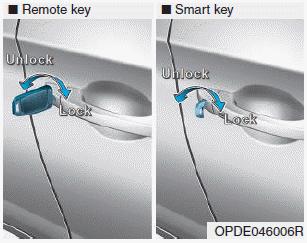Hyundai i-30: General Information / Important Safety Notice
Proper service methods and repair procedures are essential for safe, reliable
operation of all motor vehicles as well as personal safety of the operator.
The service procedures and descriptions in this shop manual provide general
directions for service and repair.
There are various procedures, techniques, tools and pars for service as well
as the skill of technicians.
Therefore, it is impossible for this manual to provide advice or caution for
each case.
Accordingly, if you use a replacement part, service procedure, or tool which
are not recommended by the vehicle manufacturer, make sure that neither the
personal safety nor the safe operation of the vehicle is jeopardized.
| •
|
Reminds you to be especially careful in those areas where carelessness
will cause death or serious injury.
|
|
| •
|
Reminds you to be especially careful in those areas where carelessness
may cause death or serious injury.
|
|
| •
|
Reminds you to be especially careful in those areas where carelessness
may cause personal injury.
|
|
| •
|
Gives you information that will prevent you from making errors
that could damage the vehicle.
|
|
| •
|
Gives you additional information that will help you complete
a particular procedure.
|
|
The following list contains some general WARNINGS that you should follow while
working on a vehicle.
| • |
Always wear safety glasses for eye protection.
|
| • |
Use safety stands whenever a procedure requires you to be under the
vehicle.
|
| • |
Make sure that the ignition switch is always in the OFF position, unless
otherwise required by the procedure.
|
| • |
Set the parking brake when working on the vehicle. If you have an automatic
transaxle, set the vehicle in the P position.
|
| • |
Place supporters against the front and rear surfaces of the tires to
prepare for the vehicle suddenly moving.
|
| • |
Operate the engine only in a well-ventilated area to avoid the danger
of carbon monoxide poisoning.
|
| • |
Keep yourself and your clothing away from moving parts when the engine
is running, especially the drive belts.
|
| • |
To prevent serious burns, avoid contact with hot metal parts such as
the radiator, exhaust manifold, tail pipe, catalytic converter and muffler.
|
| • |
Do not smoke while working on a vehicle.
|
| • |
To avoid injury, always remove rings, watches, loose hanging jewelry,
and loose clothing before beginning to work on a vehicle.
|
| • |
When it is necessary to work under the hood, keep hands and other objects
clear of the radiator fan blades! Your vehicle may be equipped with
a cooling fan that may turn on, even though the ignition switch is in
the OFF position. For this reason care should be taken to ensure that
the radiator fan electric motor is completely disconnected when working
under the hood and that the engine is not running.
|
Tightening Torque Table
of Standard Parts
BOLT (Nominal diameter)
NUT (Nominal diameter)
BOLT/NUT Normal screw
Torque Nm (kg...
Identification Number
Identification Number Description
Vehicle Identification Number
1.
World Manufacturer Identifier (WMI)
- TMA : Passenger vehicle
2...
Other information:
Description and operation
Description
The Electronic Throttle Control (ETC) System consists of a throttle body with
an integrated control motor and throttle position sensor (TPS). Instead of the
traditional throttle cable, an Accelerator Position Sensor (APS) is used to
receive driver input...
..
Categories
Operating door locks from
outside the vehicle
Mechanical key

Turn the key toward the rear of the
vehicle to unlock and toward the front
of the vehicle to lock.
If you lock/unlock the driver's door
with a key, a driver’s door will
lock/unlock automatically.
read more
 General Tightening Torque Table
General Tightening Torque Table Identification Numbers
Identification Numbers





